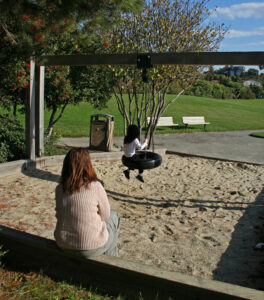After reading the recent article in the Commonwealth Beacon calling for improvements to Massachusetts’ child protection system, I was reminded of the work that REACH advocates do every day, and of a situation I encountered several years ago that highlights what the article is talking about.
=======================
At a previous job, I worked with a family that had limited English proficiency and were affected by domestic violence (DV). They don’t know the culture here very well. They aren’t aware that they’re not supposed to hit their child when the child isn’t following directions. The child goes into school and sees the Clinician, who notices the welt on the child’s arm. The child is still learning English and couldn’t explain exactly what happened. The Clinician does not speak the child’s language and tries to use language line to help. The Clinician calls in a report. The report is accepted with child removal.
The child’s mother is seeing a DV advocate, trying to flee from her abusive partner.  The mother is taking classes to learn English and how to live in this country. At home, she is assaulted by her partner. Then she gets a call from the school, saying the Police are there and that the child is being removed for safety reasons and will not return home until they can investigate. The mother manages to escape after her partner falls asleep and she is on the streets. She calls the DV hotline to ask for help. She is able to find a shelter, however it is a couple of hours away from the community she knows. Once there, she tells her advocate about the situation with her child. She shares that in her country, it is acceptable to hit kids with a belt when they are naughty, but she would never have done that if she had known it was not okay here. The advocate took time to share the different parenting styles in this country and what the laws allow. The mother needed help learning about the system of parenting in this country. She already knew how to keep her child safe and provide him with his basic needs.
The mother is taking classes to learn English and how to live in this country. At home, she is assaulted by her partner. Then she gets a call from the school, saying the Police are there and that the child is being removed for safety reasons and will not return home until they can investigate. The mother manages to escape after her partner falls asleep and she is on the streets. She calls the DV hotline to ask for help. She is able to find a shelter, however it is a couple of hours away from the community she knows. Once there, she tells her advocate about the situation with her child. She shares that in her country, it is acceptable to hit kids with a belt when they are naughty, but she would never have done that if she had known it was not okay here. The advocate took time to share the different parenting styles in this country and what the laws allow. The mother needed help learning about the system of parenting in this country. She already knew how to keep her child safe and provide him with his basic needs.
The advocates immediately help her find her child. She meets with the “system” and after several days they provide her with a “plan and deliverables” that she did not understand. The advocate had to translate the information into her language. She was told they had run out of the information pamphlet in her language. She was also informed that until she completes things like parenting classes and meets with the assigned case manager regularly, she will not be able to be with her child or initiate supervised visits. It took time to get this information. The mother’s case had been transferred three times and each time the advocate and mother called for information very little was shared. It was not until a volunteer attorney assisted the mother that they found out that the case was transferred and who the case manager was.
She is informed that because she is homeless, they can’t return her child to her custody. She had to coordinate transportation with her advocate to go to court and do visitations. Weeks went by and she was without her child. Eventually, enough advocacy occurred to reunite the mother with her child despite her being in a shelter.
The child she knew was different and did not speak except to cry and scream. This child who was once friendly with people and enjoyed school and playing ball, no longer existed. This child had nightmares. This child wet the bed  frequently. This child displayed anxiety attacks at the thought of being separated from his mother to attend school. Meanwhile, the mother was warned that if the child did not attend school he would be removed again. The advocate and the mother were able to work on a transition plan with the school to allow the child to attend school while the mother was “volunteering” in the classroom. This worked to help the child, but it made it harder for the mother to find work and move out of the shelter. Although the system finally allowed the child to return, it took far too long.
frequently. This child displayed anxiety attacks at the thought of being separated from his mother to attend school. Meanwhile, the mother was warned that if the child did not attend school he would be removed again. The advocate and the mother were able to work on a transition plan with the school to allow the child to attend school while the mother was “volunteering” in the classroom. This worked to help the child, but it made it harder for the mother to find work and move out of the shelter. Although the system finally allowed the child to return, it took far too long.
A conversation was had with the school about what the actual cost was for this family when a phone call was made without enough information or awareness of differences in culture. I was a Clinician and the advocate at the time that was supporting this case. I wasn't taught a lot about domestic violence while obtaining my degree. I also know that during our internships, we do not have a lot of exposure. Even less about cultural diversity and humility. I was fortunate enough to work for a DV agency and knew a lot about different ways to support survivors. In this situation, the Clinician did what they thought was right to protect the child. The cost of trying to protect was very high in this case. If we are to prevent families from being further hurt just because they are different in culture, language, abilities, race, ethnicity, and so on, we need to do better with creating prevention that actually demonstrates impact. Imagine if that Clinician had more exposure to differences and actual bias had been addressed frequently, how different the outcome would have been for that family. The mother, a survivor, was already working towards freeing herself and her child from an abusive situation. She did not need the extra system barriers to prevent her from creating a healthier space for herself and her child.
She said it best “If we can commit to these five principles, we have a real chance at creating a child welfare system that both supports families and protects children. We can build it, together.”





